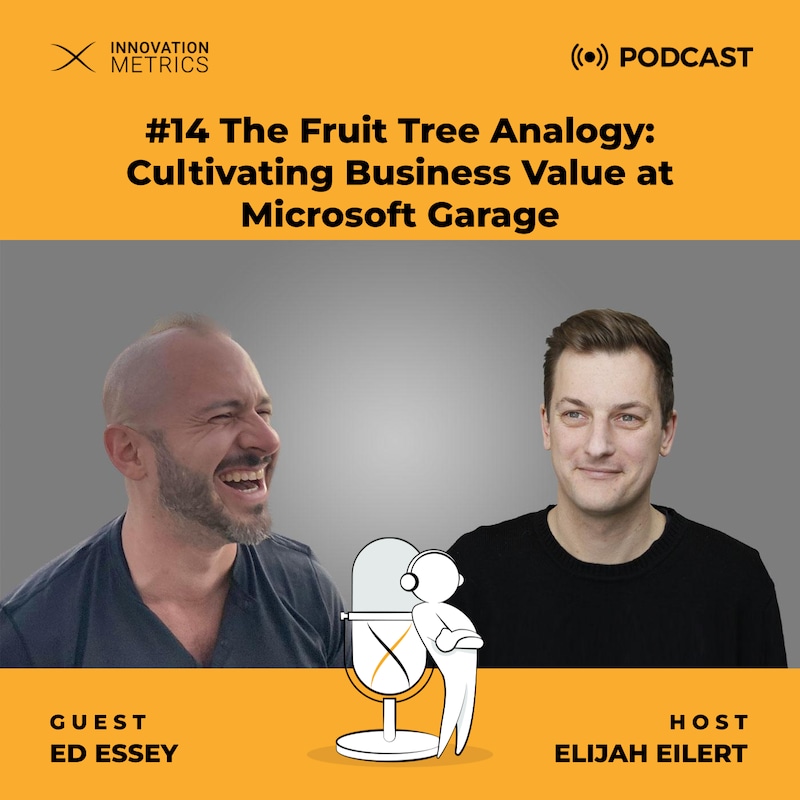About the Episode
Elijah Eilert is talking to Ed Essey Director of Business Value at the Microsoft Garage. In this episode, Ed introduces an analogy of an fruit tree to explain innovation. The tree represents the innovation system that delivers fruit or innovation projects. The soil is the nourishing culture for the tree to produce. Unsuccessful fruits fall down and become fertilisers for the tree. Ed emphasizes the importance of creating organisational ambidexterity to execute known businesses while creating entirely new ones. The discussion on measuring innovation explores innovation accounting and dives into storyboarding, hypothesis-driven financial modelling, ‘Stakeholder Development’, modelling and what metrics to focus on. Further the three factors in decision-making: merit, alignment, and executive judgment. This episode covers lots of ground in an authentic chat with a great human being.
About the Guest
Ed Essey helps intrapreneurs have, test, and grow brilliant ideas in the Microsoft Garage. He is an MIT grad, serial founder, and veteran product leader who is passionate about technology, creating great culture, and innovating through experimentation.
During his engineering career, Ed has researched AI, worked on Microsoft Office, and democratized parallel computing. He has led company-wide change management programs in innovation, design-thinking, and agile methodologies that have helped over 25,000 employees earn raving fans for their products. He is the founder of the Garage experimental outlet that has delivered over 150 new and exciting projects to market.
Ed practices mindfulness to bring his most courageous and caring self to every connection. He champions wise technology, because the best products cannot stop at intelligence, they need wisdom. Ed lives in Seattle with his two children. To find out more about Ed, please visit edessey.com to read his articles on innovation, incubation, and growth.
Connect with Ed
LinkedIn / Twitter / Website / Medium
Topics and Insights
[00:02:00] Defining Innovation – Discussing the difference between invention and innovation and how innovation is taking something new or a new approach to something and following it through until a problem is solved.
[00:02:46] Innovation as an Fruit Tree – Ed introduces the analogy of an fruit tree to explain innovation. The tree is the system or program that delivers fruit i.e. innovation projects. The soil is the nourishing culture for the tree. If an innovation doesn’t work out and the metaphorical fruit falls to the ground, it is not seen as a failure but the gained insights or learnings become fertiliser for the soil.
[00:06:16] Organizational Ambidexterity – Ed talks about the importance of creating organisational ambidexterity, which is to be able to relentlessly execute unknown businesses on the one hand and then on the other hand to be able to create entirely new businesses.
[00:09:52] Measuring Innovation – How to measure innovation/how should innovation be measured?
- How the concept of innovation accounting coined by Eric Ries was a bit hard to figure out
- How Tristan Kromer worked on it and created a clear answer for Ed with the Innovation Accounting Program
- David Binetties concept of Innovation Options
- Ed covers how he has modelled his internal innovation program using innovation accounting
- How to model from a manager’s perspective
- How to use the results to influence and drive outcome
- On Stakeholder Development (Borrowing from the term Customer Development).
- Make sure to ask managers and sponsors questions and try to flip the conversation on its head.
- How the Innovation Accounting Program led to Ed changing his title from Entrepreneurship at Microsoft to Director of Business Value at the Garage
[00:17:00] Modeling Business Strategy – Ed shares his experience of modelling his boss’s business strategy as a funnel, using innovation accounting. Emphasizing the importance of understanding the overall strategy and metrics of the organisation.
[00:27:52] Sponsorship and Project Selection – Discussion on the importance of project selection and sponsorship, and the potential bias in selecting only sponsored projects.
[00:30:01] Factors in Decision Making – The three factors in decision making: merit, alignment, and executive judgment, and the importance of understanding how executives make decisions
[00:33:55] Understanding Manager’s Goals – The importance of understanding a sponsor’s charter and goals, and how to have a compelling conversation to show how an idea can support their strategies.
[00:36:28] Sponsor Development – The concept of sponsor development, which is similar to customer development, and the importance of understanding a sponsor’s goals and perspective.
[00:37:14] Measuring Innovation – Discussion on how to measure innovation and the importance of defining the word “should” more crisply
[00:37:48] Challenges of Measuring Innovation – Exploring the challenges that large corporations face in measuring innovation at scale.
[00:41:03] Storyboarding and Innovation Accounting – Discussion on the Innovation Accounting Program and the importance of storyboarding and hypothesis-driven financial modelling for measuring innovation.
[00:47:38] Adapting to Change – Challenges engineers face with transitions and adapting to change.
[00:48:24] Asking Questions – Transitioning to discussing the three questions that will make up the podcast.
[00:49:30] Innovation Blockers – About the main blockers for innovation in large organisations.
Innovation Accounting Program
https://kromatic.com/programs/innovation-accounting
https://innovationmetrics.co/workshops/innovation-accounting-course/

